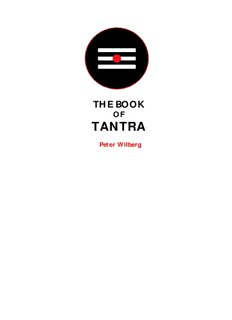
This would be the smallest format that Antony Rowe prints PDF
Preview This would be the smallest format that Antony Rowe prints
THE BOOK OF TANTRA Peter Wilberg CONTENTS PREFACE.................................................3 WHAT IS ‘TANTRA’?...............................4 TANTRA REBORN.................................10 THE MYTHS OF BIOLOGY.....................16 THE TRUTHS OF TANTRA....................17 WHAT IS ‘TANTRIC SEX’?.....................22 SHIVA AND SHAKTI.............................23 NON-SEXUAL OR SEXUAL?....................24 LOVE AND LOVE-MAKING...................33 THE SOUL-SCIENCE OF SEX...................40 WHAT IS ‘KUNDALINI’?........................42 WHAT IS AWARENESS?.........................47 SEXUAL SOUL CURRENTS......................54 SEXUAL FLOW COUPLING....................58 SHIVA-SHAKTI UNITS...........................60 THE NEW YOGA OF SEX.......................61 SOUL-BODY BREATHING......................65 YONI AND LINGAM..............................73 LIGHT OF THE TANTRAS......................83 GETTING PHYSICAL..............................91 BLACK SERPENT POWER......................96 2 PREFACE This book presents a profoundly new understanding of sexual or ‘tantric’ yoga and of the very nature of sex itself – seeing it not as a biological drive or bodily activity but as a sensual activity of soul. Its aim is to affirm the innate sensuality of the soul and its body, and in this way offer ways of ‘putting soul back into sex’. Traditional terms such as ‘kundalini’ belonging to the Old Yoga and New Age ideas of ‘tantric sex’ are reinterpreted in a completely new light – the light of a New Tantra of the soul body and of ‘soul sex’. 3 WHAT IS ‘TANTRA’? Rarely do those who study the teaching and practices known collectively as TANTRA ever ask themselves a simple question? Where, when and in what manner did these metaphysical principles and meditational practices arise - and from what knowing? For the wordless inner knowing or ‘gnosis’ that is the source of any spiritual tradition is not identical with the symbolic form taken by that tradition. 4 The metaphysical treatises or TANTRAS of the 10th and 11th century teachers identified with KASHMIR SHAIVISM ran contrary to the traditional religious philosophy and values of the VEDAS. That is because they were the final, most sublime and sophisticated expression of an entire cultural value system – not that of the high-caste Vedic priests or Brahmins but that of the under- privileged, low-caste sections of Indian society – in particular farmers and artisans. At the heart of this value system was the rejection of ritualistic religion and the caste 5 system, respect for women, and above all, veneration of the human body - the principle that “there is nothing in the universe that is not in the body”. Direct ‘empirical’ knowledge derived from sensuous bodily activity and experiencing was valued more highly than abstract intellectual knowledge - and recognised as the source of the latter. A root meaning of TANTRA is ‘loom’. Its generic meaning was the guarding (TRA) and spreading or propagation (TAN) of any form of scientific knowledge arising from any sensuous bodily activity – whether weaving or 6 love making – knowledge that itself wove together different dimensions of human sensuous activity. Within this value system, a teacher or GURU was seen as someone with developed experiential and practical knowledge of any sort. A spiritual teacher or SIDDHA- CARYA was someone capable in practice of fully embodying their inner soul powers or SIDDHIS. All of the original 84 SIDDHA-CARYAS were low- caste artisans or labourers. These powers were identified with the goddesses or SHAKTIS (from the Sanskrit root SHAK – 7 meaning creative capability, potentiality or power). The male principle was awareness (CHIT) – personified by SHIVA and individualised in the human soul. But because the soul itself was understood as the aware inwardness of the body, the body itself was revered as the supreme abode of the gods. The essence of TANTRA was and remains the understanding that the supreme form of all knowledge is bodily knowledge: DEHAVIDYA. DEHAVIDYA in the exoteric sense is the ‘implicit’ or ‘tacit’ bodily knowing that allows us 8 to engage in everyday activities such as walking, talking, driving a car or making love. Out of the experiential and experimental deepening of this inner bodily knowing came a DEHAVIDYA of another sort – an inner or esoteric knowledge of the body in all its inner and outer dimensions. It was this esoteric knowledge, made explicit in metaphysical treatises and meditational practices, that constituted the tradition of TANTRA as it is known today. 9 TANTRA REBORN What would it be like to be able to arouse yourself and your partner - no matter how tired or lacking in ‘energy’, ‘drive’ or ‘libido’ you feel? What would it be like, as a hetero-sexual man - or as a gay- lesbian or bisexual partner embodying a masculine bearing - to feel yourself entering and filling a woman fully - yet without any physical penetration? What would it be like, as a heterosexual woman – or as a gay-lesbian or bisexual partner embodying a feminine bearing, to be able to open 10
Description: